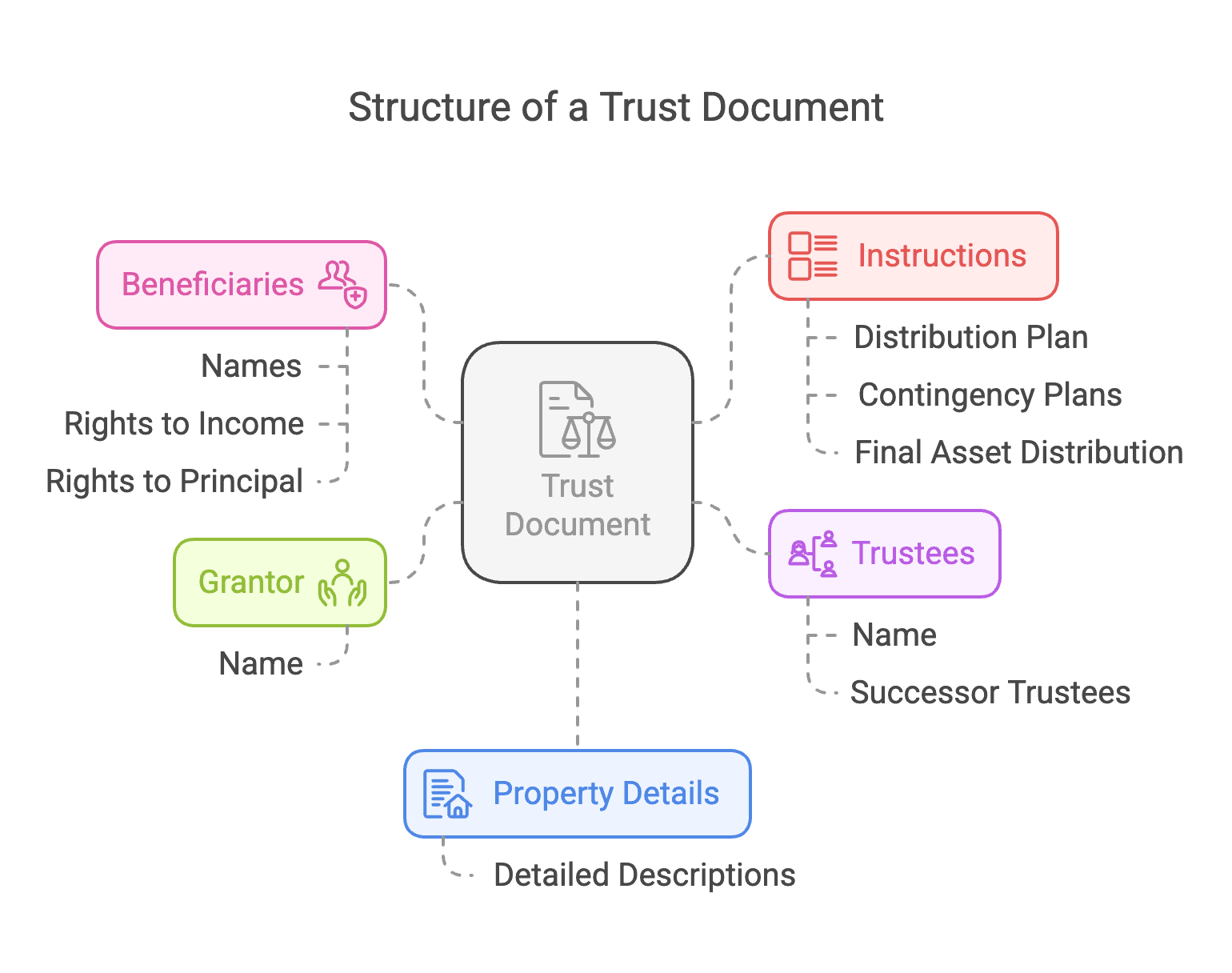Did you know setting up a living trust is the smartest way to protect your assets and make life easier for your loved ones? Moreover, you can easily set up a living trust to avoid probate and handle your estate according to your wishes. However, you must avoid common mistakes that can cause legal problems, delays, or unnecessary costs.
Your living trust holds your real estate, bank accounts, and investments. It can be passed on to beneficiaries according to your instructions. A living trust can avoid probate, provide more privacy than a will, and smooth asset distribution.
Professional legal help can secure your legacy in the best possible way. Fales Law Group is the trusted choice for providing the required support and confidence.
Contact us today to make sure your living trust is set up correctly.
In this blog post, we’ll disclose how to set a living trust in simple steps and how to avoid 10 common mistakes.

How to Set Up a Living Trust in 5 Simple Steps?
While setting up a trust sounds overwhelming, it’s pretty straightforward. Here’s how to set up a living trust in five simple steps:
1. Decide What Type of Trust You Need
Before creating a trust, you need to choose the right one. There are two main types of living trust:
- Revocable Living Trust: It lets you keep full control over your assets while you’re alive. You can update, change, or even cancel the trust anytime.
- Irrevocable Living Trust: This type of living trust cannot be changed. It removes assets from your estate, which can help protect them from creditors and reduce estate taxes.
2. Choose a Trustee and Beneficiaries
Your trust needs trustees and beneficiaries to work properly. Here’s what they do:
- Trustee: You’ll need to pick a successor trustee who will take over when you pass away or if you become unable to manage your life or financial affairs.
- Beneficiaries: You can divide your assets among your children or give specific amounts to different people.
3. List the Assets You Want in the Trust
You’ll need to decide what to include in your trust. You can put the assets into the trust that you want to pass smoothly to your heirs without probate. Here are some common assets people put in a living trust:
Real Estate
This includes your primary residence, vacation homes, and any rental properties. Placing real estate in a trust can help avoid probate and ensure a smooth transfer of ownership to beneficiaries.
Bank Accounts
You can include checking accounts, savings accounts, and money market accounts. These accounts can be retitled in the name of the trust to facilitate direct access for the trustee.
Investments
This category encompasses stocks, bonds, mutual funds, and other investment accounts. Including these assets in a trust allows for organized management and seamless transfer upon your passing.
Business Ownership
If you own a business, placing it in a trust can provide continuity and protect its value for your beneficiaries. This ensures that business operations can continue without disruption in the event of your incapacity or death.
Personal Property
Valuable personal items such as jewelry, artwork, collectibles, and other tangible assets should be included to ensure their safekeeping and proper distribution to heirs.

4. Create and Sign the Trust Document
To make the trust document official and legally binding, you must create and sign the document before a notary. Here are the options and necessary steps you need to take:
Creating the Trust Document
This involves drafting the legal document that outlines the terms of your trust. You have a few options here:
- Hire an Attorney: An estate planning attorney can create a trust document tailored to your specific needs and goals. This is especially important for complex situations.
- Use an Online Legal Service or Software: Services like LegalZoom can help you create a trust document by answering questions and filling in forms.
- Use a Form: You can purchase a living trust form and complete it. However, be cautious with generic forms as they may not comply with your state’s laws or fully address your needs.
Key Elements of the Trust Document
The document will include essential information such as:
- Your name (as the grantor).
- The names of your trustees and successor trustees.
- The names of your beneficiaries.
- Detailed descriptions of the property you intend to include in the trust.
- Instructions on who receives what when you pass away.
- Beneficiary rights to income and principal.
- Trustee powers and limitations.
- Trustee succession order.
- Contingency plans if beneficiaries die before you.
- Instructions for final asset distribution.

Signing the Trust Document
To create a valid living trust, you must sign the trust document.
Notarization
Most states require your signature to be notarized before your trust is enforceable. You can find a notary public at your bank, some print shops, or through online notary services. Having the document notarized serves as evidence that your signature is genuine. In Florida, two witnesses are required.
Review
Before signing, carefully review the document to ensure it accurately reflects your wishes. It’s best to have an estate planning attorney review the form to ensure it complies with your state’s laws and supports your best interests.
After creating and signing the trust document, the next crucial step is to transfer property into the trust to “fund” it.
5. Transfer Your Assets Into the Trust
You must transfer ownership of your assets to the trust, or they’ll go through probate. For real estate, you can update your property deed to list the trust as the new owner. In the US, some banks let you change the trust’s ownership, while others require you to open new accounts in the trust’s name.
Avoid 10 Mistakes to Perfectly Setting Up a Living Trust
Most of you can make simple mistakes that could lead to probate, legal disputes, or financial losses. Here are 10 common mistakes to avoid and how to do it right.
- Failing to Fund the Trust: If you don’t fund your trust in time, your assets could still go through probate. Funding a trust changes the ownership of your assets from your name to the trust’s name.
- Choosing the Wrong Trustee: The wrong trustee choice can cause mismanagement, conflicts, or legal issues. You can pick someone trustworthy and financially responsible. You can also consider a neutral third party.
- Not Updating the Trust: If you don’t update your living trust regularly, your assets could end up in the wrong hands. Your trust should always reflect your current wishes. You can update it after marriage or divorce, birth or adoption of a child, death of a beneficiary or trustee, etc.
- Overlooking State-Specific Laws: Not all trusts and laws work the same way in every state. Laws can vary in different states, and if you move, your trust may not be valid or require adjustments. So, you should always check with an estate planning professional if you move to make sure your trust still works as before.
- Forgetting Contingent Beneficiaries: Contingent beneficiaries provide a backup plan in case of unexpected events. If your primary beneficiary passes away before you and there’s no backup, your assets could end up in probate.
- Not Considering Taxes Rightly: Many people assume a trust will simply eliminate taxes, but that’s not true in some cases. However, some states have their own estate or inheritance taxes that could apply.
- Using Vague or Incomplete Language: If your trust instructions are too vague, it could lead to legal disputes between family members. A well-written trust should leave no room for confusion.
- Assuming a Living Trust Covers Everything: A living trust is a powerful document, but it doesn’t cover your all assets. It doesn’t cover retirement accounts (401(k), IRA), life insurance policies, and jointly owned property.
- DIY Trusts Without Legal Guidance: DIY trusts can impose risks because state laws are different in every state. Also, some essential details can be missing in these DIY trusts. For complex estates, consulting an estate planning attorney is worth it.
- Losing Track of Important Documents: Your perfect trust won’t help if no one can find it. You can store your trust documents in a fireproof safe, with your estate planning attorney, or in a secure digital storage system.

Set Up Your Living Trust With a Professional Attorney
A living trust is the perfect solution to protect your assets and make sure your loved ones avoid the hassle of probate. However, setting up a living trust the right way is significant for all of you. Your simple mistakes like forgetting to fund the trust, choosing the wrong trustee, or not keeping it updated can cause trouble in the future.
So, you must avoid these mistakes beforehand and properly fund your trust, choose a reliable trustee, and keep it updated as life changes. Consulting an estate planning attorney can help you get everything right.
Fales Law Group can take responsibility for building a legally effective living trust for you in a stress-free way. Contact us today for a free consultation and immediately secure your legacy and loved ones’ future.




